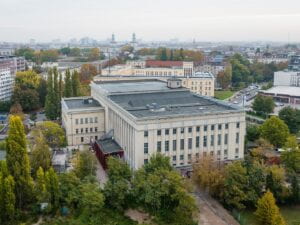by Claire Zhu*
It would be most unusual if you did not hear somebody mention Berghain in a conversation about the top nightlife spots in Berlin, a city that is simultaneously the capital of Germany and the world’s techno capital. An emblem of the city’s alternative culture, the legendary club is housed in a former industrial power plant building and exalted for its top-tier techno music. Arguably, Berghain’s most notable feature is its famed exclusivity as part of the club’s allure is its mysteriously strict door policy that makes a visit alone to such a reputable establishment a touristic experience.
Berlin Club Scene Roots in the Fall of the Wall
After the Berlin Wall fell in 1989, the reunification of the city fostered opportunities for connection between East and West Berliners. In 1949, West Berlin struck down their midnight curfew as an expression of Western values and an economic move. It was not until the Berlin Wall fell that East Berlin also eliminated their curfew, allowing for bars and clubs like Berghain to run all night long. Abandoned buildings and empty spaces left behind in East Berlin became underground venues for alternative parties and gatherings where artists, musicians, and activists organized events. In the 1990, the artistic scene and the city’s relatively low cost of living attracted young creatives seeking an expressive environment which contributed to the growth of Berlin’s cultural scene.
The Berlin Allure of Berghain
In 2004, party promoters Norbert Thormann and Michael Teufele founded Berghain at a raw concrete structure that was previously a power plant in the 1950s. Berghain was named after the two neighborhoods bordering it, Kreuzberg and Friedrichshain, and formed after Thormann and Teufele’s previous club Ostgut, which was shut down for the construction of the O2 World Arena to take place. Similarly to Ostgut, Berghain was founded with a nonconformist, hedonistic mindset and commitment to high-quality techno music that is unshadowed by the sexual liberation that takes place.
‘For many people, it’s not the music but the ‘cool factor’ that attracts them to Berghain’. DJ and producer Ali ‘Perc’ Wells (Medium)
Berghain and clubs like it are significant contributors to Berlin’s image as an edgy, avant-garde, counterculture city rich in artistic freedom. Such phone-free environments of self-expression, experimentation, and boundary-pushing challenge the traditional nightlife scene with table reservations and bottle services. As a result, Berlin has gained a reputation as a hub of creativity, attracting individuals who seek to be a part of or just visit a city that celebrates individuality and embraces what is unconventional. Berghain’s exclusivity is in part due to its commitment to retain its underground spirit and stands as a representation of the alternative image that shrouds Berlin tourism.

Urban Tourism and Clubbing
Clubs like Berghain have a cultural impact as a space for cultural exchange by allowing tourists to come and take part in the nightlife experience. Berghain’s reputation as an iconic techno club has turned it into a must-visit pilgrimage destination for techno lovers and nightlife enthusiasts from all over the world. The influx of international tourists boosts Berlin’s urban tourism sector, enhancing its global reputation as a vibrant and diverse cultural hub.
Beyond a “cool” reputation for Berlin, the nightclub scene significantly impacts Berlin’s local economy. The mass of tourists seeking to experience the club’s vibrant nightlife has resulted in increased revenue in many areas. Hospitality businesses such as hostels, hotels, and restaurants flourish due to the need for tourist accommodations. Similarly, transportation services and shopping areas gain more patronage due to there being more people in the city. Not only is there overall economic growth, but job creation also stems directly from urban tourism.
However, the commodification of the club scene in Berlin is not without its issues for the city. As attractions to the city, the nightclubs are a point of overcrowding and noise disturbance which may be a bother for the well-being of residents who live near the clubs. Furthermore, the influx of tourists may exacerbate the gentrification problem present in Berlin by making certain neighborhoods appear more attractive to outsiders for living or lodging due to the vibrant culture.
Reference List
Allyn, B. (2022, September 23). How a whiskey-fueled meeting in 1949 led to Berlin’s famed techno scene. NPR. www.npr.org/2022/09/23/1121435229/berlin-clubs-techno-berghain-kitkatclub
Paumgarten, N. (2014, March 17). Dancing through Berlin. The New Yorker. www.newyorker.com/magazine/2014/03/24/berlin-nights
Wurnell, M. (2017, April 9). The Berghain backstory: Building Berlin’s most legendary nightclub. Medium. medium.com/cuepoint/the-berghain-backstory-building-berlins-most-legendary-nightclub-87ad2d901ee9
 *Claire Zhu is a native New Yorker studying media, culture, and communication with a minor in the business of entertainment at NYU. She was at NYU Berlin for the summer semester 2023, i.e. late May to late June.
*Claire Zhu is a native New Yorker studying media, culture, and communication with a minor in the business of entertainment at NYU. She was at NYU Berlin for the summer semester 2023, i.e. late May to late June.
Image: Berhain areal view. Arne Müseler. Von Arne Müseler / www.arne-mueseler.com, CC BY-SA 3.0 de, https://commons.wikimedia.org/w/index.php?curid=124335028